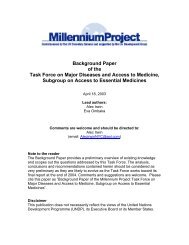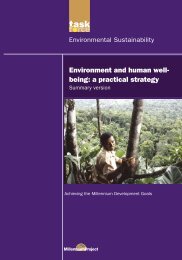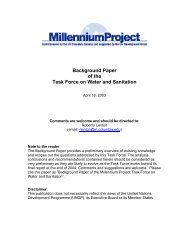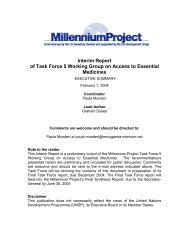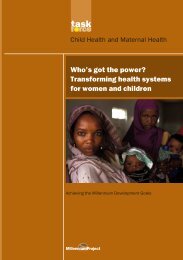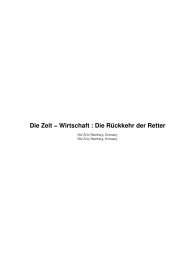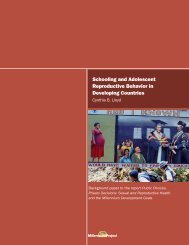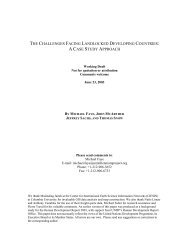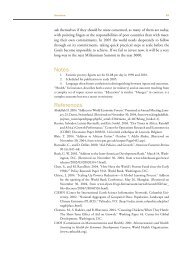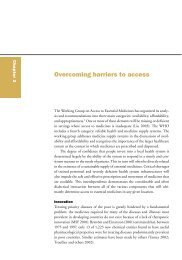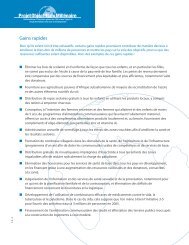Investing in Development A Practical Plan to Achieve the Millennium ...
Investing in Development A Practical Plan to Achieve the Millennium ...
Investing in Development A Practical Plan to Achieve the Millennium ...
Create successful ePaper yourself
Turn your PDF publications into a flip-book with our unique Google optimized e-Paper software.
306 Notes<br />
5. Article 25 of <strong>the</strong> United Nations International Covenant on Civil and Political Rights<br />
states only that “Every citizen shall have <strong>the</strong> right and <strong>the</strong> opportunity, [without discrim<strong>in</strong>ation]<br />
and without unreasonable restrictions: (a) <strong>to</strong> take part <strong>in</strong> <strong>the</strong> conduct of public affairs,<br />
directly or through freely chosen representatives ….” This statement of <strong>the</strong> right <strong>to</strong> participate<br />
must be seen <strong>in</strong> <strong>the</strong> context of o<strong>the</strong>r rights recognized <strong>in</strong> <strong>the</strong> Universal Declaration, which<br />
give substance <strong>to</strong> it. They <strong>in</strong>clude <strong>the</strong> right <strong>to</strong> freedom of speech, <strong>the</strong> right <strong>to</strong> nondiscrim<strong>in</strong>ation,<br />
<strong>the</strong> rights <strong>to</strong> assembly and association, <strong>the</strong> right <strong>to</strong> a free press, and so on.<br />
6. See UN (1998) on “The role of national human rights <strong>in</strong>stitutions <strong>in</strong> <strong>the</strong> protection<br />
of economic, social and cultural rights.” (E/C.12/1998/25); and see UN (2002e) on “The<br />
role of <strong>in</strong>dependent national human rights <strong>in</strong>stitutions <strong>in</strong> <strong>the</strong> promotion and protection of<br />
<strong>the</strong> rights of <strong>the</strong> child.”<br />
7. World <strong>Development</strong> Report 2005 draws this analysis from World Bank (2004a).<br />
Chapter 8<br />
1. Civil society organizations refer <strong>to</strong> a broad group of organizations and ac<strong>to</strong>rs <strong>in</strong>clud<strong>in</strong>g<br />
but not limited <strong>to</strong> community-based organizations, nongovernmental organizations,<br />
bus<strong>in</strong>ess associations, th<strong>in</strong>k tanks, social movements, religious organizations, women’s rights<br />
movements, grassroots and <strong>in</strong>digenous people’s movements, and voluntary organizations.<br />
Chapter 9<br />
1. The government holds primary responsibility <strong>to</strong> create <strong>in</strong>centives for <strong>in</strong>formal<br />
entrepreneurs <strong>to</strong> enter <strong>the</strong> formal economy—by enabl<strong>in</strong>g access <strong>to</strong> credit, better technologies,<br />
and o<strong>the</strong>r <strong>in</strong>puts, by simplify<strong>in</strong>g registration systems, and by provid<strong>in</strong>g access <strong>to</strong><br />
tra<strong>in</strong><strong>in</strong>g, as described <strong>in</strong> chapter 7.<br />
Chapter 10<br />
1. This chapter draws extensively from “End<strong>in</strong>g Africa’s Poverty Trap,” Sachs and<br />
o<strong>the</strong>rs (2004).<br />
2. A regression (not reported here) of several different governance <strong>in</strong>dica<strong>to</strong>rs on log<br />
GDP per capita PPP and a dummy for tropical Sub-Saharan Africa results <strong>in</strong> a statistically<br />
<strong>in</strong>significant coefficient for <strong>the</strong> dummy variable, <strong>in</strong>dicat<strong>in</strong>g that Africa is not governed<br />
worse, after controll<strong>in</strong>g for <strong>in</strong>come.<br />
3. O<strong>the</strong>r evidence suggests, for example, that between 1986 and 1988 long-distance<br />
freight tariffs <strong>in</strong> francophone West Africa were more than five times higher than comparable<br />
tariffs <strong>in</strong> India, Pakistan, and Viet Nam (Rizet and H<strong>in</strong>e 1993). A more recent<br />
study suggests that long-distance freight rates <strong>in</strong> Tanzania are three times higher than <strong>in</strong><br />
Indonesia (H<strong>in</strong>e and Ellis 2001).<br />
Chapter 11<br />
1. UN Department of Economic and Social Affairs, Statistics Division 2004; based<br />
on data provided by <strong>the</strong> United Nations Children’s Fund, World Health Organization,<br />
and Food and Agriculture Organization of <strong>the</strong> United Nations. The numbers represent<br />
unweighted averages for Least Developed Countries <strong>in</strong> <strong>the</strong> regions.<br />
2. The 14 priority areas <strong>in</strong>cluded: climate change and sea-level rise; natural and<br />
environmental disasters; management of wastes; coastal and mar<strong>in</strong>e resources; freshwater<br />
resources; land, energy, <strong>to</strong>urism, and biodiversity resources; national <strong>in</strong>stitutions and





